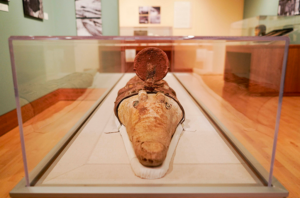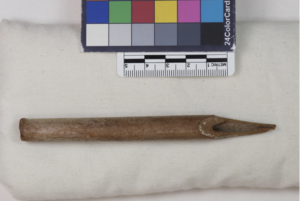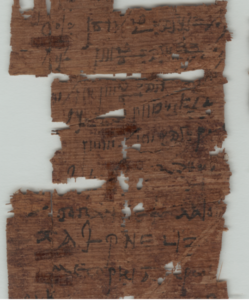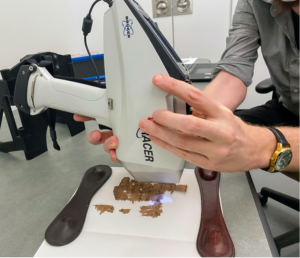By Leah Packard-Grams
Ancient History & Mediterranean Archaeology PhD student
Center for the Tebtunis Papyri
Writers in the modern world often have a favorite pen, a preferred color of ink, or quirky handwriting, and ancient writers were no different! Scribal habits are a topic of increasing interest among scholars who study the ancient Mediterranean, and UC Berkeley’s papyrus collection is full of possibilities for the topic that has set researchers abuzz.
UC Berkeley’s collection of papyri, housed in the Center for the Tebtunis Papyri (CTP) on the fourth floor of The Bancroft Library, was excavated from the sands of Egypt 123 years ago, but it has often been remarked that the collection is rich enough to provide work for generations of scholars. The papyri provide crucial insights for our knowledge of daily life in Egypt and can illuminate individual priests, artisans, and scribes in extraordinary detail. One specific group of papyri caught my attention when CTP Director Todd Hickey mentioned it in a graduate course a few years ago: the archive of a scribe who worked for a local record-office in the 70-60s BCE. Since his name has not yet been deciphered from the surviving papyri, scholars refer to him as “Scribe X”. His papyri were found in the crocodile mummies excavated in Tebtunis, Egypt, on behalf of UC Berkeley over a century ago.


1. (Left: A crocodile mummy on display in the Object Lessons exhibit, Spring 2020. Right: a reed pen from Tebtunis held in the Hearst Museum at UC Berkeley, object no. 6-21420.)
The Scribe X papyri have been examined by several scholars, and two of them have been published in full, while dozens of fragments remain to be edited.1 Previous researchers have found this archive to be unique: It not only represents the oldest collection of documents from a village record-office (grapheion in Greek), it also displays the earliest use of the reed pen (kalamos in Greek) to write the Demotic Egyptian script, which was traditionally written with a rush. The Egyptian scribes of this era did not use the reed pen for Demotic so far as we know, and it would be decades before the reed was used with regularity for the Demotic script. In other words, Scribe X had a favorite pen, and he used it even though it differentiated him from the other scribes around him. This prompted a question: If the scribe used an “atypical” writing instrument, was the ink he used likewise “atypical”?

2. (A selection of lines from Scribe X’s account papyrus P.Tebt.UC 2489, displaying Demotic and Greek written on the same document, both written with the reed pen.)
Previous studies by a team of researchers in Europe have proved that there was a shift when scribes began to add copper sulfate to ancient inks of this period in the region of Tebtunis.2 This was a development from the earlier Egyptian ink recipe of gum arabic, soot, and water. In later periods, metallic elements such as lead and copper were intentionally added to the ink to make it more durable. Did this innovative scribe use a more recent ink recipe, or the traditional gum-soot-water recipe?
To find out, a chemical analysis using X-ray fluorescence spectrometry (XRF) was conducted in collaboration with UC Berkeley’s Archaeological Research Facility. One reason scholars favor the use of XRF for testing ancient objects is because it is nondestructive and extremely safe. A portable XRF spectrometer from the Archaeological Research Facility was brought to the Center for Tebtunis Papyri, where Dr Jesse Obert (a recent PhD from the Graduate Group in Ancient History and Mediterranean Archaeology) and I scanned multiple papyri from the Scribe X archive. The XRF spectrometer contains both an x-ray emitter with a precise 5 mm beam as well as a detector which identifies photons that are ejected from the atom when it is exposed to the x-rays. Different elements emit different photon signatures, and the detector “reads” the photon signatures to identify which elements are present in the atoms of the scanned area. We selected nine areas on one bilingual papyrus for scanning and included a number of uninscribed areas on the papyrus as a control. Several other papyrus fragments from the archive were also scanned in subsequent months.

3. (Dr Jesse Obert performing the initial scan with the portable XRF)
The results of the scans were surprising: The machine did not detect any metallic elements in the ink whatsoever. From this information, we can infer that Scribe X used the traditional ink recipe without any of the ink additives that were popular in the era! Such a finding was unforeseen because studies of comparable papyri did not attest to the use of this ink. At the same time, however, it is somewhat un-surprising, because it is well known that Ancient Egyptian traditions in art, religion, language, and culture endured even beyond Alexander the Great’s conquest of Egypt in 332 BCE. What this project has proven is that this ancient ink recipe was one of these enduring traditions, holding on longer than previously thought in the area of Tebtunis.
In April 2023, I presented this study in a poster for the annual meeting of the American Research Center in Egypt and received first place in the “Best Student Poster Competition.”3 More research on the archive is forthcoming (stay tuned for an upcoming feature in the Fall 2023 issue of Fiat Lux!). The project inspired me to get my own certification in XRF scanning, and my work with the archive has allowed me to become familiar with this scribe, his quirks, and his writing habits. The project and the prestigious award it has received are testaments to the open, collaborative attitude of UC Berkeley researchers working across disciplines and across the many research facilities and hubs across campus. I am extremely grateful to Dr Todd Hickey, Dr Jesse Obert, Dr Nicholas Tripcevich, and Directors of The Bancroft Library Charles Faulhaber and Kate Donovan, whose support and encouragement has enabled this project to come to fruition!
Notes
- The two papyri published thus far are edited by Parker 1972 and Muhs & Dieleman 2006. For assessment of the Demotic material, see Muhs 2009 and 2010. The Greek material was surveyed in Hoogendijk 2013.
- See the XRF ink study in Christiansen et al., 2017.
- See Packard-Grams 2023.
Sources
Christiansen, Thomas, et al. “Chemical Characterization of Black and Red Inks Inscribed on Ancient Egyptian Papyri: The Tebtunis Temple Library.” JAS Reports 17, 2017, pp. 208-219.
Hoogendijk, Francisca A.J.. “Greek Contracts Belonging to the Late Ptolemaic Tebtynis grapheion Archive?” in Das Fayyûm in Hellenismus und Kaiserzeit: Fallstudien zu multikulturellem Leben in der Antike, Carolin Arlt, Martin Andreas Stadler, and Ulrike Weinmann, eds., Wiesbaden: Harrassowitz Verlag, 2013, pp. 63-74.
Muhs, Brian. “The Berkeley Tebtunis Grapheion Archive,” in Actes du IXe Congrès des études démotiques, G. Widmer and D. Devauchelle, eds. BiEtud. 147. Cairo, 2009, pp. 243-252.
Muhs, Brian. “A Late Ptolemaic grapheion Archive in Berkeley,” in Proceedings of the Twenty-Fifth International Congress of Papyrology, Ann Arbor, 2007. American Studies in Papyrology, Ann Arbor, 2010, pp. 581-588.
Muhs, Brian, and Jacco Dieleman. “A Bilingual Account from Late Ptolemaic Tebtunis.” Zeitschrift für Ägyptische Sprache und Altertumskunde, vol. 133, 2006, pp. 56-65.
Packard-Grams, L. . “New Pen & Old Ink: XRF Analysis of a Unique Archive from 1st c. BCE Tebtunis,” X-Ray Fluorescence Reports: Archaeological Research Facility: UC Berkeley eScholarship Publications. 2023. https://escholarship.org/uc/item/25n2k5bn
Parker, R.A. “An Abstract of a Loan in Demotic from the Fayum.” Revue d’Égyptologie 24, 1972, pp. 129-136.